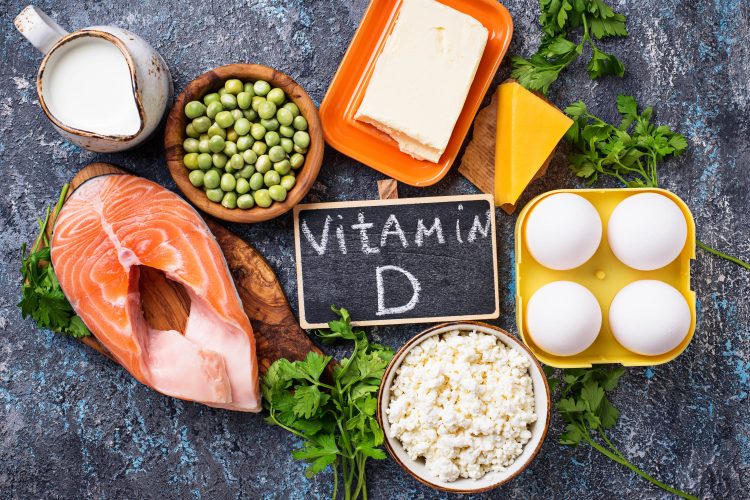(Bio)Fortification: to D or not to D?
- Like
- Digg
- Del
- Tumblr
- VKontakte
- Buffer
- Love This
- Odnoklassniki
- Meneame
- Blogger
- Amazon
- Yahoo Mail
- Gmail
- AOL
- Newsvine
- HackerNews
- Evernote
- MySpace
- Mail.ru
- Viadeo
- Line
- Comments
- Yummly
- SMS
- Viber
- Telegram
- Subscribe
- Skype
- Facebook Messenger
- Kakao
- LiveJournal
- Yammer
- Edgar
- Fintel
- Mix
- Instapaper
- Copy Link
Posted: 1 March 2022 | Dr Kirsty Pourshahidi, Erika Rosbotham, Holly Neill | No comments yet
Researchers from Ulster University summarise the latest vitamin D research and suggest how the food industry can respond to suboptimal intakes.


Vitamin D has been hitting the headlines recently due to claims it may be linked to COVID-19. But is vitamin D deficiency a concern in the UK? And, if so, how can we improve our status and what does the future hold for the food industry in terms of vitamin D?
Function of vitamin D
Arguably, the most well-recognised role of vitamin D is in the development and maintenance of normal bones, teeth and muscle tissue, as it works alongside calcium and phosphorus to ensure homeostasis. Vitamin D is also associated with normal immune functioning, explaining its possible links to COVID-19, of which evidence is currently limited and inconclusive. Therefore, a lack of vitamin D in the body may manifest in bone-related disorders such as osteomalacia (weak bones) in adults or rickets in children, in addition to increased risk of falls and fractures.
Sources of vitamin D
Vitamins (or ‘vital amine’s) are typically essential micronutrients sourced from the diet. Vitamin D, however, is known as the ‘sunshine vitamin’ owing to its production within our skin (epidermis layer) when exposed to ultraviolet-B (UVB) light. As such, vitamin D is more correctly considered a prohormone, rather than a vitamin. Several factors impact an individual’s ability to produce vitamin D from sunlight including, but not limited to, skin tone, age, sunscreen, latitude (where you live), air pollution and clothing. Therefore, the specific amount of UVB exposure required to produce sufficient vitamin D status varies, with anywhere between five and 30 minutes being proposed.
Despite UVB exposure being our main and preferred source, some foods can also provide the body with vitamin D, albeit generally in relatively low levels. Dietary vitamin D sources include oily fish, egg yolk and liver, in addition to meat, fortified products and mushrooms. The two main forms of vitamin D are vitamin D3 and D2, the former of which is found in animal-based products and considered more effective in increasing 25-hydroxyvitamin D (25(OH)D),1-3 a robust and reliable biomarker for vitamin D status. For those following a vegan diet, vitamin D2 is preferred as it is not produced from animal sources.
Vitamin D deficiency
Within Europe, approximately 40 percent of the population is deficient in vitamin D.4 Certain subgroups of the population have increased risk of poor vitamin D status such as religious groups who choose to cover the majority of their skin, and those who are housebound, owing to decrease in skin synthesis. However, of note, significant debate surrounds the exact definition of vitamin D insufficiency and deficiency, with various cut-off values between <25 to <50 nmol/L postulated.5-7 This can present challenges when comparing the severity of vitamin D deficiency between countries.


Sunshine is often said to be one of the largest sources of vitamin D
Dietary requirements
The UK Scientific Advisory Committee for Nutrition (SACN) recommends that everyone aged four years and older should consume 10µg (400 IU) vitamin D per day. Yet, one in five of us do not reach this and the average vitamin D intake in the UK is less than a third of this recommended value (3µg)8. To address this shortcoming, owed to limited sunlight exposure and dietary sources, a daily supplement (10µg) is encouraged to be taken between September and April to achieve a sufficient vitamin D status.
This recommendation varies slightly across Europe, however Ireland also advises 10µg supplementation for the general population and 15µg for those housebound with limited sunlight exposure.9 This year, a new report proposed a 20-25µg per day (800-1,000 IU/day) vitamin D supplement for the entire adult Irish population and recommended > 20-25µg per day for vulnerable adults.10
Vitamin D fortification and biofortification
It is clear that vitamin D is important for health and yet intake levels are suboptimal. So what solutions are available? And how does the food industry respond? When perusing a supermarket aisle there can be an overwhelming selection of fortified foods and beverages.
Taking a ‘food first’ approach, these may offer clear consumer advantages by requiring no change to an individual’s usual habitual diet yet simultaneously improving nutritional intake. For vitamin D, breakfast cereals, spreads, juices, milk and dairy products are among the most popular vehicles for fortification. Notably in the UK, no mandatory fortification policy exists, except for infant formula. Finland is often praised for the success of its fortification policy which has resulted in significant vitamin D intake increases across the population.
Milk is a staple dietary component for a large proportion of the UK and Irish populations, making it an excellent commodity product for vitamin D fortification. Our research from Ulster University, in collaboration with the Dairy Council for Northern Ireland, used a dietary modelling exercise to predict how fortified cows’ milk could theoretically improve overall dietary vitamin D intakes of the UK population. Results were encouraging, demonstrating fortification of cows’ milks with 1, 1.5 and 2µg vitamin D/100g, theoretically increasing median vitamin D intakes from 2.0 µg/day to 4.2, 5.1 and 5.9 µg/day, respectively. At the highest level (2 µg/100g), the proportion of the population meeting the new dietary recommendations would increase to just over 12 percent (from <1 percent) and the greatest impact would be apparent in children.11
Endogenous vitamin D biofortification is also an exciting emerging area of research, which differs to traditional fortification by naturally increasing the vitamin D content of a product, rather than artificially adding it to a food or beverage. Studies have previously explored the feasibility of naturally increasing vitamin D in pork, beef, cattle, eggs, yeast (bread) and mushrooms12 with mixed results. While UV-treated yeast contained increased vitamin D, this did not translate to an improved vitamin D status when biofortified bread was consumed by human participants in a clinical trial.13
Eggs, fish and mushrooms, however, have shown positive outcomes. Despite on-farm studies showing the benefit of UV exposure in vitamin D blood and meat results from animals, its bioavailability has not been tested in humans.12
Following on from our earlier work in milk in collaboration with Devenish Nutrition and the Agri-Food Bioscience Institute (AFBI), we have investigated the feasibility of pork meat as a food vehicle for vitamin D biofortification. Vitamin D enrichment may be achieved by feed supplementation or changing the animal housing environment to include UVB exposure. Meat is the main contributor to vitamin D intakes in the UK and our on-farm pig studies have shown that exposing pigs to daily UVB significantly increases vitamin D3 content. Recently published in Frontiers in Nutrition,14 using dietary modelling we theoretically predicted that UK vitamin D intakes could increase by 20 percent if the vitamin D content in pork meat was increased by 200 percent via UV biofortification. Current research involves the use of supervised machine learning techniques applied to our on-farm pig studies to identify factors that influence the vitamin D enrichment process with the aim of establishing a pathway to commercialisation.15
Shortly, we will also be publishing results from the first human trial investigating the impact of consuming biofortified pork meat, as well as further exploring this important research area in another pig trial and sensory evaluation of vitamin D-enriched meat products, all to inform our next human trial – watch this space!
Conclusion
Vitamin D is incredibly important for our overall health, particularly in relation to bone and immune function. Yet, vitamin D intakes and status remain low. Consequently, we must find additional food-based strategies to target this serious concern. This provides an opportunity for the food industry to further explore possibilities for fortification and biofortification. Naturally, the biggest impact will be seen if a variety of foods were mandatorily enriched to ensure the greatest number of consumers could be reached, so we have only just scratched the surface of investigating this approach. Over the coming months, we hope to further add to this exciting area of research with the aim of minimising vitamin D deficiency and decreasing associated disease risks.
References
- Tripkovic L, Lambert H, Hart K, et al. (2012) Comparison of vitamin D2 and vitamin D3 supplementation in raising serum 25-hydroxyvitamin D status: a systematic review and meta-analysis. The American Journal of Clinical Nutrition, 95(6), 1357–1364.
- Bouillon R, Verlinden L, Verstuyf A. (2016) Is vitamin D2 really bioequivalent to vitamin D3? Endocrinology, 157(9), 3384–3387.
- Wilson LR, Tripkovic L, Hart KH, Lanham-New SA. (2017) Vitamin D deficiency as a public health issue: using vitamin D2 or vitamin D3 in future fortification strategies. Proceedings of the Nutrition Society, 76(3), 392-399.
- Cashman KD, Dowling KG, Škrabáková Z, et al. (2016) Vitamin D deficiency in Europe: pandemic? The American Journal of Clinical Nutrition, 103(4), 1033–1044.
- Holick MF, Binkley NC, Bischoff-Ferrari HA, et al. (2011) Evaluation, treatment, and prevention of vitamin D deficiency: an Endocrine Society clinical practice guideline. The Journal of Clinical Endocrinology and Metabolism, 96(7), 1911–1930.
- Institute of Medicine. (2011) Overview of Vitamin D. In: Committee to Review Dietary Reference Intakes for Vitamin D and Calcium, Ross, A. C., Taylor, C. L. and Yaktine, A. L. ed. Dietary reference intakes for calcium and vitamin D. Washington (DC): The National Academies Press (US). Available at: https://www.ncbi.nlm.nih.gov/books/NBK56061/ [Accessed 8 July 2021].
- Scientific Advisory Committee on Nutrition (SACN). (2016) Vitamin D and Health. London: SACN. Available at: https://assets.publishing.service.gov.uk/government/uploads/system/uploads/attach ment_data/file/537616/SACN_Vitamin_D_and_Health_report.pdf [Accessed 19 August 2019].
- Public Health England. (2020a) NDNS: results from years 9 to 11 (combined) – data tables. London: Public Health England. Available at: https://assets.publishing.service.gov.uk/government/uploads/system/uploads/attach ment_data/file/943623/NDNS_from_years_1_to_9_data_tables__1_.zip [Accessed 27 May 2020].
- Food Safety Authority of Ireland (FSAI). (2020) Vitamin D Scientific Recommendations for Food-Based Dietary Guidelines for Older Adults in Ireland. Dublin: FSAI. Available at: https://www.fsai.ie/DietaryGuidelines_OlderAdults_Ireland/ [Accessed 15 October 2021].
- Houses of the Oireachtas. (2021) Report on addressing Vitamin D deficiency as a public health measure in Ireland. Dublin: Joint committee on health. Available at: https://data.oireachtas.ie/ie/oireachtas/committee/dail/33/joint_committee_on_heal th/reports/2021/2021-04-07_report-on-addressing-vitamin-d-deficiency-as-apublic-health-measure-in-ireland_en.pdf [Accessed 15 October 2021].
- Weir RR, Johnston M, Lowis C, et al. (2020) Vitamin D3 content of cows’ milk produced in Northern Ireland and its efficacy as a vehicle for vitamin D fortification: a UK model. International journal of food sciences and nutrition, 72(4), 447–455.
- Neill HR, Gill CIR, McDonald EJ, et al. (2021a) The future is bright: Biofortification of common foods can improve vitamin D status. Critical Reviews in Food Science and Nutrition, 1–17 [Advance online publication].
- Itkonen ST, Skaffari E, Saaristo P, et al. (2016) Effects of vitamin D2-fortified bread v. supplementation with vitamin D2 or D3 on serum 25-hydroxyvitamin D metabolites: an 8-week randomised-controlled trial in young adult Finnish women. The British Journal of Nutrition, 115(7), 1232–1239.
- Neill HR, Gill CIR, McDonald EJ, et al. (2021b) Vitamin D Biofortification of Pork May Offer a Food-Based Strategy to Increase Vitamin D Intakes in the UK Population. Frontiers in Nutrition [Advance online publication].
- Rosbotham EJ, Rankin D, Gill CIR, et al. (2021) The use of supervised machine learning techniques to identify factors influencing vitamin D bio-enrichment of pork. Proceedings of the Nutrition Society. Cambridge University Press, 80(OCE3), p.E141.
About the authors




Holly Neill is a final year PhD researcher within the Nutrition Innovation Centre for Food and Health (NICHE) at Ulster University, Northern Ireland. She has previously worked in the food industry and her current research focuses on the feasibility of meat as a vehicle for vitamin D biofortification.


Related topics
Health & Nutrition, Regulation & Legislation, Research & development, The consumer
Related organisations
Scientific Advisory Committee for Nutrition (SACN), Ulster University









